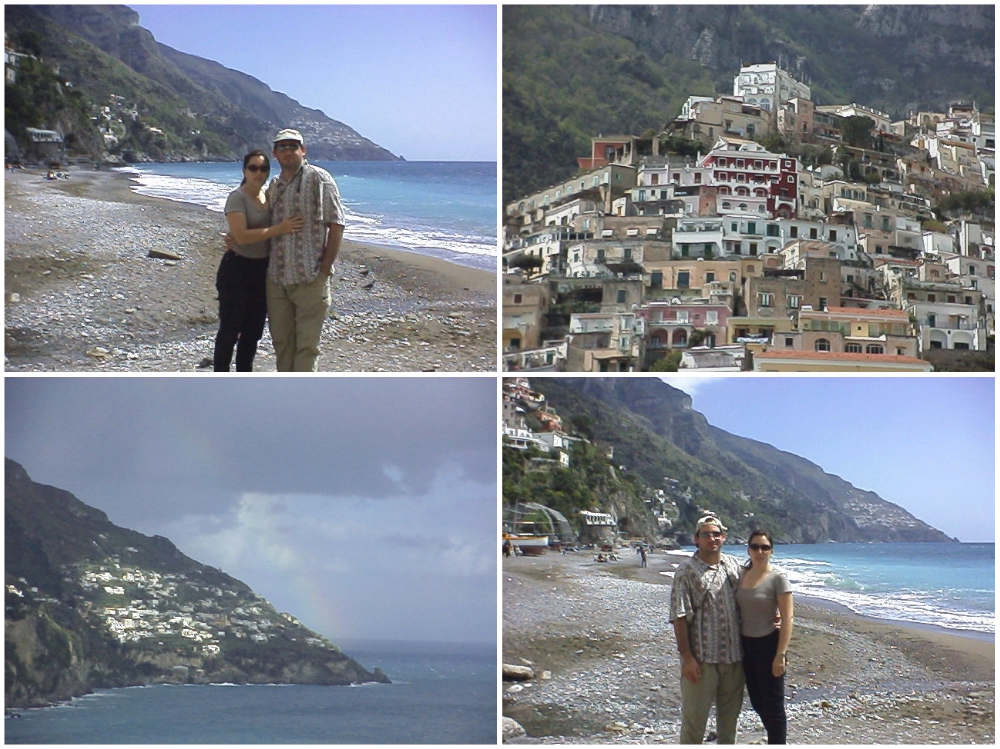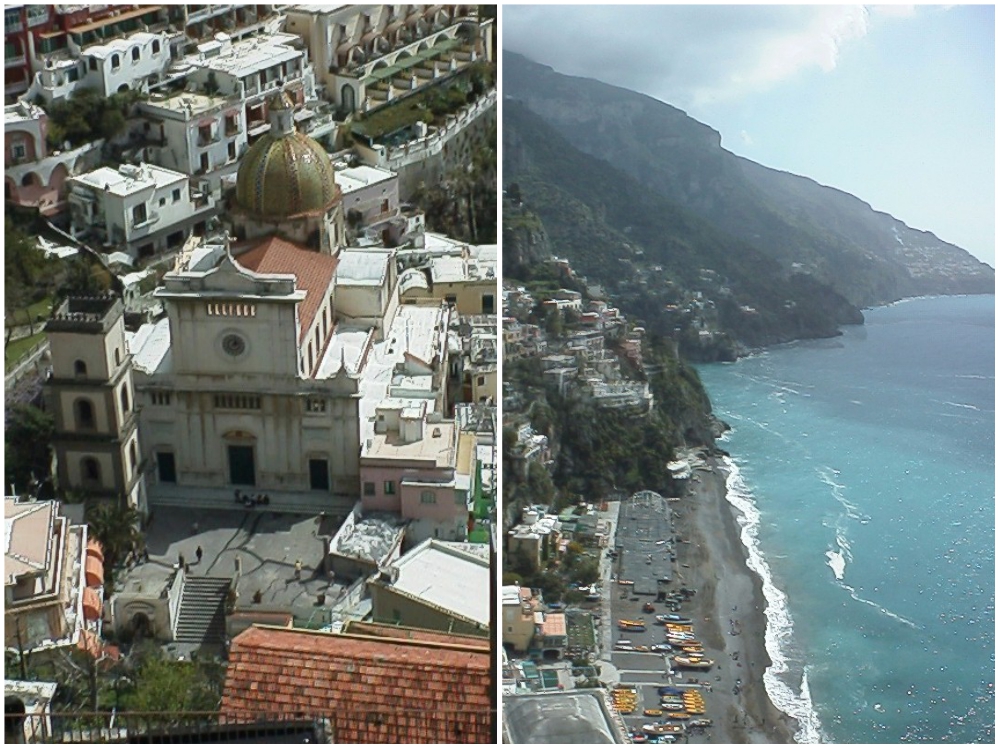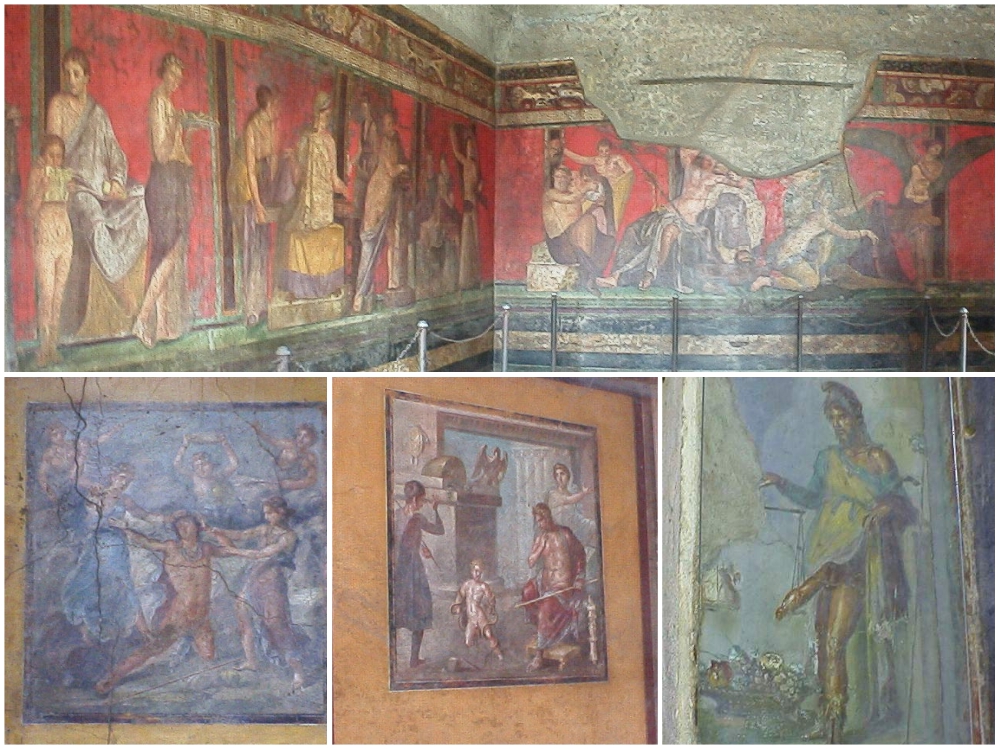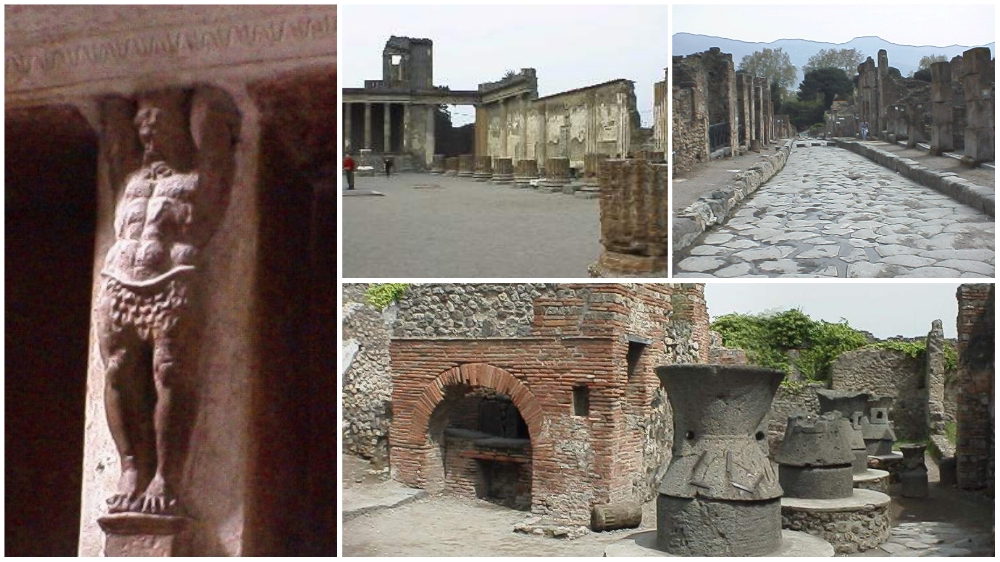
Around the World in 1998-1999; The Amalfi Coast and Pompeii
Note; this post is recreated from the original wired2theworld website post with the dates below. The old posts were reformatted for the 20th anniversary of wired2theworld. As much as possible, the content is unchanged and unedited from the original, only some formatting, spelling, and link errors have been corrected.
Table of Contents
Palermo to Naples on the Ferry
David’s Diary:
April 12, 1999
The Crossing
We were not surprised to find ourselves pulling into the Port of Palermo several hours before we were supposed to be there to board the ferry. However, we had no more energy for sightseeing, and nowhere else to go. The ship was right where she was supposed to be, to my amazement, but they were not yet ready to let passengers or cars on. We parked the car at the head of the lane where cars would eventually line up and wait to drive up the ramp into the Ship’s hold. Both of us were involved in fat novels, which we promptly extracted form the trunk, and began to read.
After a two hour wait, and slow but deliberate convergence of automobiles upon the line behind us, all the big trucks had been loaded on our ship, and it was 6:00. We proceeded up the ramp and were directed to the front corner space, which was by far the most difficult to leave from, ensuring that we would be the last off the boat from this deck. There was a second-level parking as well, which had an identical spot. I didn’t feel so bad.
We wander into the chaos of the ship, climbing several levels until we locate a steward, who looks at our tickets and waves us to an elevator, where he pushes us in and hits the button for the deepest level under the parking area in the hold. There is a small block of second-class cabins squeezed into the bowels of the ship, with no windows, and where the dull grind of the engines can be heard from somewhere not far enough away. This was our home for the night. We had only brought a small bag with us, fortunately, because the hallways were narrow, and each section was partitioned by an emergency door which obviously shut if there was a problem, entombing anyone who happened to be in their cabin at the time. I didn’t feel great about it, but the ship was full and we could not get a first-class seat even two days in advance.

We read for a little while in the upper lounge, until the kids became unbearable, and we heard that the cafeteria was open. Dinner was food. That’s all. We finally leave Sicily, just after 8:00 pm, en route to Naples. We returned to our lounge, and sat on the other side, to avoid the kids. Not long into the voyage, the weather begins to have an effect on Kristina. The ship, although large, was rocking about in the rough seas of the Mediterranean. Dutifully, we had taken our motion sickness pills one hour before the trip, but it was getting to Kristina nevertheless. We went down to the cabin and tried to read in there, hoping that the lower we were on the ship, the less intense the motion would be. Kristina didn’t say much. She just curled up on her bunk, sometimes reading, sometimes not, fighting the good fight against the urge to hurl. I was all right, and Kristina made it the whole way without yarbling her tacos, losing her lasagna, or tossing her tagliatelle.
If you’d like to see a different trip to Sicily in 2003 with better photos, go here.
Naples to Positano
David’s Diary:
April 13, 1999

Positano
We put into Bella Napoli at 7:30 am. The skies were dark and it was raining hard. Our plan had originally been to stop at Pompeii on the way, and spend the day there before going on to Positano. We drove to Pompeii despite the rain, and found that the rain was not giving up, so we did. We left Pompeii, and set out to Positano early, vowing that we would return.
Positano is on the Amalfi Coast, the southern side of the peninsula which forms the lower (southern) half of the Bay of Naples. The road to the Amalfi Coast is one of those legendary routes which is barely wide enough for a cow to pass a sheep, as it winds treacherously along magnificent sheer cliffs that plunge onto spears of rock that protrude from the aquamarine waters below. It is as beautiful as a place can be, but because of its extreme terrain, the access is difficult.
This does not stop the inexorable train of tour busses from their daily march along the Costa Amalfitana. The driving event of the day did not involve a bus this time, to my relief. We were still driving on the north side of the peninsula when I noticed a typical Italian driver making the fantasy third lane in my rear view mirror. Then, just before we entered a 2 km. long tunnel, I noticed it was a hearse. Once in the tunnel, a two-way, two lane, absolutely no passing allowed zone, the hearse careened out in to the oncoming lane and powered by us. I slowed down to hurry him by, and he just made it before hitting the oncoming truck head on. What was really amusing to Kristina and I, however, was that the coffin was in the hearse. This guy was late for his own funeral! Several kilometers down the road, we came upon the church, where the coffin was being unloaded off the hearse, to a crowd of obviously annoyed people in black suits, smoking cigarettes. How late was he?
We had made a reservation from Palermo at one of the pensions listed in the book, but when we saw it, we were disappointed. It was too far out of town. The thing about Positano, is that it is a vertical village. Part of its charm and romance comes from the steep stairways and walking paths that crisscross the town. Most of the shops and the restaurants are lower down, at the beach level, but there a few others scattered up and down the hill.
I first came to Positano in 1995 (K came once with her mom before that), when we got married, and stayed in a beautiful little hotel about halfway up the hill with a stunning view and a jacuzzi tub in a giant marble bathroom with its own spectacular view. There was a terrace that just hung out over the village and the sea, with a view to cry for. We adored this place. Given that we were not happy with the location of the little pension where we had a reservation, and we were quite early, we decided to look at a few other places. When we came to the Casa Albertina (the hotel from our honeymoon), we looked at each other, had one of those quirky moments, and went in. We both knew that it was too expensive, realistically for our budget, which was extremely tight at this point of the trip. We decided that we would only consider it if the same room was available.
What ensued is not difficult to surmise. We asked for a room, specifically 33, which he told us was occupied. But, he had something like that room, if we wanted to see it, so we reluctantly went with him. We told him the story of our prior visit, and he said that he thought he recognized us. When he opened the door to the room, both Kristina and I knew that we had the room number wrong, it was 31. We were looking at the same room we had spent a bit of our honeymoon magic in. It didn’t take us too long to decide to stay there, and even though the weather was poor, we decided to stay two nights. We called the other pension and canceled our reservation with no problems. One note. We were so thrilled to have this room again, that we forgot to check the telephone. It worked to call out, but was a specialized local computer run system, which used its own special signals to trigger the dialer in the main phone at the front desk. We could not use the computer to dial out. We had failed the teachings of lesson #2. Fortunately, this place was a first-class hotel, and the guy at the front desk understood exactly what I needed, and why, and let me use the front desk phone, which was a touch-tone with no complications. We dialed right up and got the mail. Whoopee. Nothing of importance, so we decided not to check it again while we were in Positano. We were ready for this break in a big way.
To that end, we copped an instant beach attitude and sauntered down to one of our favorite restaurants in Positano, Chez Black. It is one of the well-known beachfront places, that has become larger than life because of the popularity of the town. One advantage of knowing a town from prior experience is knowing where to eat. I remembered their wood oven-fresh pizzas were terrific, and their pasta was great, too. Their seafood is exceptional, but then, so is everybody’s here. The town is very much a fishing village, and that is one thing you can buy with confidence. We ordered a delicious bottle of Orvieto Classico, Podere di Ciano, 1997 DOC and we had linguine al pesto and a pizza capricciosa for 53,000L. We were so happy to back in Positano, and especially under the circumstances, we had managed to arrange. It was terribly romantic, and a fitting way bring another big chapter of the voyage to a near close.

Kristina’s Journal:
April 14, 1999
First let me say that my husband has been saying ever since we left Positano three and a half years ago that we would go back there, and stay in the same hotel, in the same room. Incurable romantic that he is, I could not help but give in when he looked at me with those puppy dog eyes, begging that we stay for two days, no matter the cost. I had to say yes, just to see the joy on his face, even though I knew it was a budget-buster. After all, this would be the last hotel we stayed in until we went home, and well, again, I just couldn’t say no.
We decided to make the most of our time there and spent half the day in the sunshine on our balcony. We had considered driving to Pompeii for the day, but why leave paradise? Around lunchtime, we walked down the 200 or so steps to the beach, peeked in the typical tourist shops, and even checked out one of the nicer hotels in town, the Pallazzo Murat which is situated in an 18th century palace of a former King of Naples. This place has prices that only a King could afford, but it is beautiful. Trying to save a bit of money, we went into a little market and had them make us some sandwiches which we then took to the beach. It was a beautiful day, thought not hot enough to go in the water, so we just sat shore side and watched the other tourists and the local fishermen.
After last night’s disappointing dinner at O Capurale, we decided to go with what we knew was good, and went back to Chez Black. On the way back up to the hotel, the streets we fairly deserted, and suddenly we heard singing. It was coming from a garage-like room near the bottom of the steps that lead to the beach. Walking closer, we saw that it was not a garage, but a fisherman’s storage shed. The old fisherman and his wife were inside, and as they stood, untangling and repairing their nets, they were singing an old Italian fishing song. Or at least that’s what it sounded like to us. It was a moment that not even the tourist board of Positano could have planned better and it ended the night perfectly.

Pompeii
Kristina’s Journal:
April 15, 1999
Positano to Champery via Pompeii
Because we couldn’t bring ourselves to leave our sunny balcony yesterday, we knew today would be a long day. Not only were we going to drive over 1200 KM to Switzerland, but we were going to stop at Pompeii along the way. The site at Pompeii was easily an all day event, but we were going to have to make it relatively quick. Fortunately, we were blessed with much nicer weather today. upon arrival at the site, we discovered that there was free entrance to all sites and museums in Italy this week. Great, except that this was our last sightseeing venture in the country. Still, it saved us 20,000L.
I had been here before, six years ago, but David had never seen Pompeii. As we entered through a new entrance, I noted many changes, including much more of the excavation open to the public. I saw so much that I somehow missed the last time, and so much that was new, that I was glad to have gone again.
Unlike the Forum in Rome, which is only the remains of municipal and merchant buildings, the excavation of Pompeii includes an entire thriving city that was quickly buried under ash during the eruption of Mt. Vesuvius in 79 AD. The occupants of the city were quickly killed by poisonous gasses and the suffocating ash covered them up to 7 meters (21 feet) thick. This preserved not only the bodies, but homes, temples, shops, marketplaces, roads, bathhouses, brothels, and all the contents of the buildings down to the paintings on the walls. Some of the buildings, especially the suburban villas would be considered quite luxurious even by today’s standards.

One of these villas I somehow missed the last time I was here. It is called the Villa of the Mysteries and it is considered a “suburban villa” located on a road about a quarter of a mile from the main entrance to Pompeii. The villa has many rooms, most of which the walls are still standing containing the original frescos. Before the eruption in 79 AD the villa contained a kitchen with two ovens, a sauna, two bathrooms, a bedroom, and a wine cellar with a grape press (which very much impressed David). All these rooms center around a large, Tuscan-style atrium in the middle of the house. The ceiling was open to the sky in the center and quite often these rooms contained a fountain in the middle.
The most famous room of the villa is called the Large Painting Room, and contains the largest continuos narrative painting to have survived ancient times. it is believed to show the different stages of the rite where the brides were initiated into the Cult of Dionysus.
David’s Diary:
Pompeii is simply enormous. I would suggest to anyone that they pack a lunch, some water, and wear good shoes. There is one food concession inside, and it is horrible. You will get hungry because the place is too big to visit in less than a few hours. If it is hot, it is very hot there, so water in the summer is a must. The roads of the entire city are grooved from the chariot wheels and are tricky to walk on, so wear something that will hold up. No flip flops, or shoes with high heels. When you pass over the first hill you get a sense of just how big this place is. You are looking at an entire city that was flash-frozen in time from end to end. The level of preservation is mind-blowing, as you walk into rooms where the ash-crusted bodies of human beings are in the positions they held when Vesuvius erupted. Many were laying down with their hands covering their heads. There are a few displays that show where the bones of the corpses are exposed from beneath the baked ash, so you know that there are truly bodies in there. There are outdoor holding rooms for artifacts on display, and there is a lot of stuff. Jugs, amphorae, plates, statues, tools, utensils, and some furniture are all tagged and on shelves next to more bodies in the storage where they can be seen by the public. The excavation is ongoing, and the site continues to expand.

The color frescoes that survived are in varying degrees of quality. There are some, like the Villa of Mysteries, where they are in near mint condition. Others are more damaged or faded, but worth seeing. The Villa Vettius, or Vettii House, depending on your guide book, is very well preserved and the walls of some rooms were covered in erotica. The frescoes depict all different kinds of sexual positions. There are more erotic frescoes in the brothel. The second story is still intact at the brothel, and the downstairs is filled with tiny rooms with a stone bed. The walls of the hallway and the rooms are covered with drawings and engravings that detail sexual positions.
The center of town is the Forum. This is where the markets would have been held. In fact, several of the buildings off the forum were once specialty markets, like the fish market. The remnants of the once majestic temple are recreated in a detailed presentation board. The entire place is awe inspiring. The streets feel different than at other ruined cities, because all the houses are still here in this one, not just the ground on which they once stood.

There are several bathhouses, all worth seeing. They had cold tubs (frigidarium), and medium tubs (tepidarium), and hot tubs (calidarium). There were giant circular tubs of various sizes, and places with a row of private tubs as well. These people were definitely cleaner than their post Roman, European ancestors. All of the tubs are still intact. In the houses, the kitchen counters and the cooking stoves are still intact. All of them. Its kind of eerie, actually, kind of like the way an earthquake takes out every chimney, but in reverse. They were clearly an advanced society, and the thought that they were wiped out in one brief instant looms heavily as one walks the streets.
We spent 2 1/2 hours there and could have easily spent much more, but we had to get on the road. We had an exceptionally long drive ahead of us, over 1000 kilometers into unknown weather. We heard it might be snowing in the alps!!
We’ve been back to Italy many times since this trip.
For more Pompeii and Amalfi Coast, check out our main Italy Page.
Have you been to the Amalfi Coast? Thinking of going?
Leave me a comment below and make my day!
NOTE: Everything on this trip was paid for by us. Nothing was complimentary or given in exchange for reviews or promotions.
Any post on this site may contain affiliate links. Thank you for supporting wired2theworld by using our links to shop, book hotels, or organize tours. If you use them, they cost you nothing extra but we may make a small commission that helps us to continue to provide helpful and free content. This specific post has no affiliate links.



